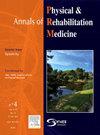与成人相比,严重脑外伤后7-8年儿童的总体残疾相似,但死亡率和运动损伤情况不同
IF 4.6
3区 医学
Q1 REHABILITATION
Annals of Physical and Rehabilitation Medicine
Pub Date : 2025-03-21
DOI:10.1016/j.rehab.2025.101961
引用次数: 0
摘要
损伤年龄影响严重创伤性脑损伤(TBI)后的功能结局,但在同时包括儿童、青少年和成人的研究中,其作用仍未得到充分探讨。目的探讨不同年龄组重型脑外伤后7 ~ 8年损伤年龄对死亡率和总体失能的影响。方法两个前瞻性纵向队列评估了39名儿童/青少年的总体功能结局[创伤严重儿童(TGE)队列,平均受伤年龄M(SD) = 7.5岁(4.6岁),范围0.3至14.7]和86名成人[PariS-TBI队列,M(SD) = 34.1岁(13.7岁),范围15.4至74.8],持续严重TBI[格拉斯哥昏迷量表(GCS)≤8]。两项研究都收集了基线人口统计学(年龄、性别、教育水平)、初始损伤严重程度(GCS、损伤严重程度评分[ISS]、昏迷时间)和死亡率的数据。随访评估包括临床评定的总体残疾[格拉斯哥结局量表扩展(GOS-E)],临床/神经恢复,以及评估学校/工作情况、焦虑/抑郁和照顾者感知负担的自我/代理报告问卷。结果与儿童/青少年相比,成人的死亡率明显更高,昏迷时间更长,持续运动缺陷更频繁。与成人相比,儿童/青少年损伤后7 - 8年的良好恢复率(GOS-E)增加(P = 0.03)。在多元线性回归分析中,GOS-E与总样本和成人的GCS评分和损伤前教育相关。在这两个年龄组中,总体损伤后残疾与学校/工作适应和运动缺陷、焦虑/抑郁增加和照顾者负担增加有关。这些发现揭示了儿童、青少年和成人在严重脑外伤后的恢复和残疾的不同年龄特征,强调了对每个群体进行量身定制的评估和干预的必要性。此外,他们强调有必要对儿童和青少年进行长期随访,以评估他们向独立生活和职业融合的过渡。未来的研究应证实这些结果,并确定促进康复和减少长期残疾的可修改因素。本文章由计算机程序翻译,如有差异,请以英文原文为准。
Similar overall disability but different mortality and motor impairment profiles in children compared to adults 7–8 years after severe TBI
Background
Age at injury influences functional outcomes after severe traumatic brain injury (TBI), but its role remains underexplored in studies that simultaneously include children, adolescents, and adults.
Objectives
To investigate the effect of age at injury on mortality and overall disability 7 to 8 years post-severe TBI across diverse age groups.
Methods
Two prospective longitudinal cohorts assessed overall functional outcomes in 39 children/adolescents [Traumatisme Grave de l'Enfant (TGE) cohort, mean age at injury M(SD) = 7.5 years (4.6), range 0.3 to 14.7] and 86 adults [PariS-TBI cohort, M(SD) = 34.1 years (13.7), range 15.4 to 74.8], who sustained severe TBI [Glasgow Coma Scale (GCS) ≤8]. Both studies collected data on baseline demographics (age, gender, education level), initial injury severity (GCS, Injury Severity Score [ISS], length of coma), and mortality rates. Follow-up assessments included clinician-rated overall disability [Glasgow Outcome Scale-Extended (GOS-E)], clinical/neurological recovery, and self-/proxy-reported questionnaires assessing school/work situation, anxiety/depression, and caregivers’ perceived burden.
Results
Adults evidenced significantly higher mortality rates, longer lengths of coma, and more frequent persistent motor deficits than children/adolescents. Children/adolescents exhibited increased rates of good recovery (GOS-E) 7 to 8 years post-injury compared to adults (P = 0.03). In multivariate linear regression analyses, GOS-E was associated with GCS score and pre-injury education in the total sample and adults. In both age groups, overall post-injury disability was associated with the presence of school/work adaptations and motor deficits, increased anxiety/depression, and higher caregiver burden.
Conclusion
These findings reveal distinct age-specific patterns of recovery and disability after severe TBI among children, adolescents, and adults, highlighting the need for tailored assessments and interventions for each group. Furthermore, they underline the necessity of prolonged follow-up in children and adolescents to evaluate their transition to independent living and professional integration. Future research should confirm these results and identify modifiable factors that promote recovery and minimize long-term disability.
求助全文
通过发布文献求助,成功后即可免费获取论文全文。
去求助
来源期刊

Annals of Physical and Rehabilitation Medicine
Medicine-Rehabilitation
CiteScore
7.80
自引率
4.30%
发文量
136
审稿时长
34 days
期刊介绍:
Annals of Physical and Rehabilitation Medicine covers all areas of Rehabilitation and Physical Medicine; such as: methods of evaluation of motor, sensory, cognitive and visceral impairments; acute and chronic musculoskeletal disorders and pain; disabilities in adult and children ; processes of rehabilitation in orthopaedic, rhumatological, neurological, cardiovascular, pulmonary and urological diseases.
 求助内容:
求助内容: 应助结果提醒方式:
应助结果提醒方式:


